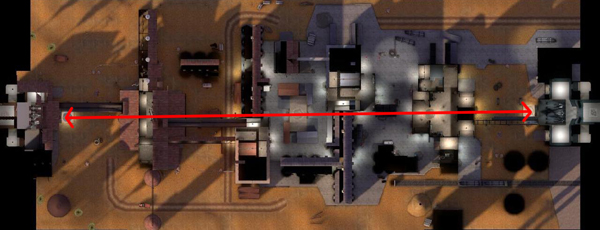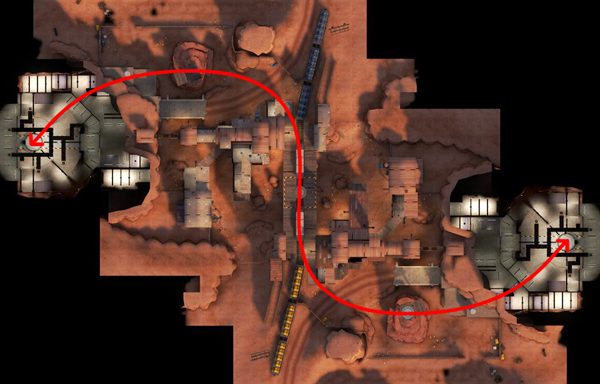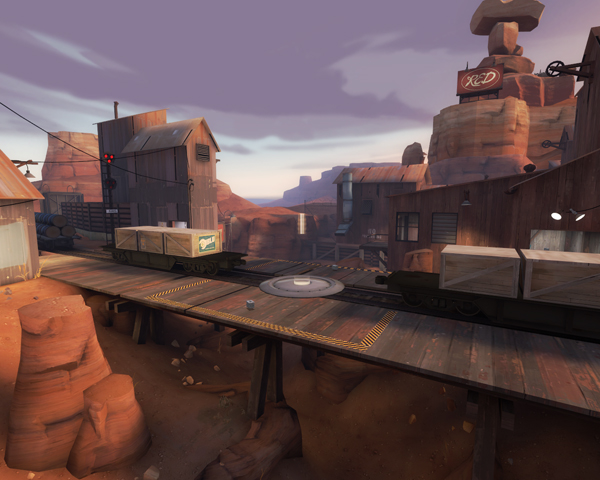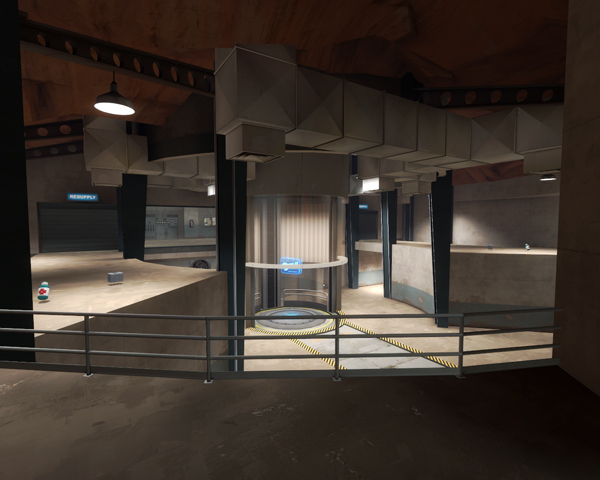Introduction:
After building a 5cp map and liasing with members of both the competitive and public scene during its development i thought i would document some of the things i noticed along my journey to late beta. I was hesitant to post it as TF2 has been around many years now and seen many community maps officiliased, especially 5CP push ones. Many authors have their own experiences, some more successful than others and so the value of this article may be a less than what it might have been earlier in TF2's lifetime, but if it just helps 1 person or sparks further discussion then perhaps it will be worth posting anyway. After all, the work is already done, created as a personal study.
Index:
5CP options
mirrored 5cp maps
linear 5cp maps
displaced (S shaped) 5cp maps
Control point limitations
CP3
CP1
CP2
What does this amount to?
Final thoughts
5CP options:
5CP will always come with certain design issues that are difficult to overcome, but most notably in it's limitations for variance, an attack/defend map's capacity to be asymmetrical provides a near infinite amount of possibilities in layout designs creating a large repertoire of potential unique maps with their own unique experiences. On the other hand a 5CP's trend to be symmetrical along one axis or another limits variety; specifically in its central and final control points. Meaning that the second control point's positioning will actually define the nature of your map, falling into one of 3 specific criteria which can classify your 5CP push map. Linear, displaced or mirrored.
Mirrored:
Authors tend to avoid mirrored map designs because it comes with an inherent balance issue in that the firing path of projectile weapons from the player is offset to the right where the weapon is positioned on the UI, so one team will always be at an advantage around particular corners in a map. This can be offset by providing multiple corners and turns throughout the map that allow both teams to exploit the projectile path at multiple locations within a map so that it tends to even out the advantage-disadvantage across the maps layout; but it is impossible to prevent this entirely, particularly at the central control point where the map mirrors, which is a significant issue considering the significance of this location. The initial battle for "mid" can often dictate a teams success in that round.
Linear:

A linear map like granary will provide more capacity for uniqueness using a variety of height variations and CP positions that don't exist in official linear 5cp maps, like granary and well. Granary is very flat, besides some ramps at mid and a ledge at CP2, so there is potential for minor changes to the control point positions and the maps height variation to create something more fresh from this base layout and not have it receive a “granary clone” stigma. Linear 5CP designs however do come with more problems that require resolving, the travel distance cannot be shortcut so class speeds are emphasised in the initial skirmish for “mid”. Valve have mixed up various resolutions such as round gates for granary and well but these are rather intrusive measures and don't affect mid-game game play.
Displaced (Or S shape):

Badlands has an overwhelmingly efficient layout design compared to the rest and whether this was achieved by fluke or by purpose remains to be seen. The history of the map is that it was a CTF map for TFC, so the "shortcut" past CP2 from primary spawn to mid was more of an alternate path than an objective shortcut as there was no significance to the CP2 location in the original map. But certain obvious layout design choices for things like roll-out (keeping the shortcut past CP2) and optimisation (position of solid structures between CP 2 and 3) make it difficult to vary a layout with the control points displaced either side of “mid” the way that they are and not be stuck with what is fundamentally still “badlands”. A map that displaces its second control point to the side to bring CP1 closer to mid will always sink into the badlands “mould” and the trouble for the map author is in creating a map that doesn't have the stigma of a badlands clone.
To avoid this, differing the height of each location will reduce the likeness to badlands, but there are only so many height variations to execute before looking like badlands or another custom 5CP map; also we're stuck with limitations at the central location that also affect the surrounding geometry.
Limitations of 5CP control point design:
“Mid”:

Because CP3 is the middle of a map it has to be balanced through symmetry, “mid” always has to be in the middle of the local area which immediately limits your design options to something central. This is the primary inherent limit of 5CP (when not mirrored). Designs tend to be focused around something of aesthetic importance like a ledge or a minor structure, a bridge, a hut/tower, a ditch. All of which have been done before and become rather cliché. It's very hard to create a 5CP central point that is of an original design; and choosing either one will give you certain design problems further down the road.
“Final”:

The final point tends to be flush against the back of a base with the defenders spawn close behind/above it. Again, this limits variation in design between maps but the height variation can be switched up somewhat and depending on whether the map is “linear” or “displaced” will depend on whether your base will be more symmetrical down its centre. Displaced map designs tend to have less symmetrical designs to provide paths to both CP2 and mid; and the final point doesn't necessarily have to be centralised, but is usually done so anyway because it tends to balance more naturally by reducing game play variables you will have to work with.
“Second”:

CP2 is basically where you will have the most opportunities to separate your map from the rest, your mid will tend to be typical and though your final point will also likely adhere to particular trends despite artistic license, you have the opportunity to switch up aesthetics more freely at your second control point. As long as it is balanced to spawn waves and travel distance this is pretty much the only location you can let your imagination loose in a “displaced” 5CP design as the rest will be influenced by dividing walls and attempts to limit lines of sight and increase balance through symmetry.
What does all this mean?
Linear maps allow for more design variation on the part of the author but comes with additional design problems that have no real effective solution; such as roll out. Because of this people attempting 5CP will avoid linear 5CP if they can because it comes across as boring and needlessly problematic compared to the alternatives.
Similarly, the inherent game play problems as a result of the base layout for linear map designs, emphasised by class perks, is a similar “additional” issue for mirrored maps, which tend to be avoided as balance is incredibly important to competitive TF2. Mirrored maps receive a smaller following of fans and less likely to receive publicity due to being ignored by leagues as a result of the projectile weapon firing path.
Displaced is the single most popular 5CP design approached by amateur level designers, especially by those who are interested in the competitive scene. The layout is proven and the potential for fluid height variation is a tasteful opportunity. However the standard response from the competitive community is “It's not badlands”, and a map author has to go far out of his way in order to create a displaced 5CP layout design that doesn't eventually begin to look like badlands throughout its development. From experience in creating such a design and including feedback from the competitive community, over the course of a year each modification to make ,y 5CP push map play better brought the map closer and closer to looking like badlands. A bridge in the middle, a spire at second and a final CP sat in front of the primary spawn room that has exits on either flank.
Final thoughts:
Of course in the end you could opt for a completely non-symmetrical 5CP map. Such a map would surely recieve a lot of attention, if only for it's controversial nature. Balance can be acquired in the team win ratios fairly easily but that's not to say the map wont be prone to stalemating at specific locations or have finer imbalances within its design such as those related to class and weapon perks. Balancing progression of difficulty per control point will be an extra difficult task, especially when it comes to designing the final point and spawn room position and exits. A-symmetrical maps have been made before, in fact one of my favourite TFC CTF maps, ctf_casbah, was very popular with TFC players; adhering to strict criteria, equal opportunities of height, entrance and exit ways, travel distance to flag and from spawn. So far, though, it appears no one has felt the need or motivation to take such an extreme project into hand; at least with the current, efficient opportunities possible with symmetrical maps.
After building a 5cp map and liasing with members of both the competitive and public scene during its development i thought i would document some of the things i noticed along my journey to late beta. I was hesitant to post it as TF2 has been around many years now and seen many community maps officiliased, especially 5CP push ones. Many authors have their own experiences, some more successful than others and so the value of this article may be a less than what it might have been earlier in TF2's lifetime, but if it just helps 1 person or sparks further discussion then perhaps it will be worth posting anyway. After all, the work is already done, created as a personal study.
Index:
5CP options
mirrored 5cp maps
linear 5cp maps
displaced (S shaped) 5cp maps
Control point limitations
CP3
CP1
CP2
What does this amount to?
Final thoughts
5CP options:
5CP will always come with certain design issues that are difficult to overcome, but most notably in it's limitations for variance, an attack/defend map's capacity to be asymmetrical provides a near infinite amount of possibilities in layout designs creating a large repertoire of potential unique maps with their own unique experiences. On the other hand a 5CP's trend to be symmetrical along one axis or another limits variety; specifically in its central and final control points. Meaning that the second control point's positioning will actually define the nature of your map, falling into one of 3 specific criteria which can classify your 5CP push map. Linear, displaced or mirrored.
Mirrored:
Authors tend to avoid mirrored map designs because it comes with an inherent balance issue in that the firing path of projectile weapons from the player is offset to the right where the weapon is positioned on the UI, so one team will always be at an advantage around particular corners in a map. This can be offset by providing multiple corners and turns throughout the map that allow both teams to exploit the projectile path at multiple locations within a map so that it tends to even out the advantage-disadvantage across the maps layout; but it is impossible to prevent this entirely, particularly at the central control point where the map mirrors, which is a significant issue considering the significance of this location. The initial battle for "mid" can often dictate a teams success in that round.
Linear:

A linear map like granary will provide more capacity for uniqueness using a variety of height variations and CP positions that don't exist in official linear 5cp maps, like granary and well. Granary is very flat, besides some ramps at mid and a ledge at CP2, so there is potential for minor changes to the control point positions and the maps height variation to create something more fresh from this base layout and not have it receive a “granary clone” stigma. Linear 5CP designs however do come with more problems that require resolving, the travel distance cannot be shortcut so class speeds are emphasised in the initial skirmish for “mid”. Valve have mixed up various resolutions such as round gates for granary and well but these are rather intrusive measures and don't affect mid-game game play.
Displaced (Or S shape):

Badlands has an overwhelmingly efficient layout design compared to the rest and whether this was achieved by fluke or by purpose remains to be seen. The history of the map is that it was a CTF map for TFC, so the "shortcut" past CP2 from primary spawn to mid was more of an alternate path than an objective shortcut as there was no significance to the CP2 location in the original map. But certain obvious layout design choices for things like roll-out (keeping the shortcut past CP2) and optimisation (position of solid structures between CP 2 and 3) make it difficult to vary a layout with the control points displaced either side of “mid” the way that they are and not be stuck with what is fundamentally still “badlands”. A map that displaces its second control point to the side to bring CP1 closer to mid will always sink into the badlands “mould” and the trouble for the map author is in creating a map that doesn't have the stigma of a badlands clone.
To avoid this, differing the height of each location will reduce the likeness to badlands, but there are only so many height variations to execute before looking like badlands or another custom 5CP map; also we're stuck with limitations at the central location that also affect the surrounding geometry.
Limitations of 5CP control point design:
“Mid”:

Because CP3 is the middle of a map it has to be balanced through symmetry, “mid” always has to be in the middle of the local area which immediately limits your design options to something central. This is the primary inherent limit of 5CP (when not mirrored). Designs tend to be focused around something of aesthetic importance like a ledge or a minor structure, a bridge, a hut/tower, a ditch. All of which have been done before and become rather cliché. It's very hard to create a 5CP central point that is of an original design; and choosing either one will give you certain design problems further down the road.
“Final”:

The final point tends to be flush against the back of a base with the defenders spawn close behind/above it. Again, this limits variation in design between maps but the height variation can be switched up somewhat and depending on whether the map is “linear” or “displaced” will depend on whether your base will be more symmetrical down its centre. Displaced map designs tend to have less symmetrical designs to provide paths to both CP2 and mid; and the final point doesn't necessarily have to be centralised, but is usually done so anyway because it tends to balance more naturally by reducing game play variables you will have to work with.
“Second”:

CP2 is basically where you will have the most opportunities to separate your map from the rest, your mid will tend to be typical and though your final point will also likely adhere to particular trends despite artistic license, you have the opportunity to switch up aesthetics more freely at your second control point. As long as it is balanced to spawn waves and travel distance this is pretty much the only location you can let your imagination loose in a “displaced” 5CP design as the rest will be influenced by dividing walls and attempts to limit lines of sight and increase balance through symmetry.
What does all this mean?
Linear maps allow for more design variation on the part of the author but comes with additional design problems that have no real effective solution; such as roll out. Because of this people attempting 5CP will avoid linear 5CP if they can because it comes across as boring and needlessly problematic compared to the alternatives.
Similarly, the inherent game play problems as a result of the base layout for linear map designs, emphasised by class perks, is a similar “additional” issue for mirrored maps, which tend to be avoided as balance is incredibly important to competitive TF2. Mirrored maps receive a smaller following of fans and less likely to receive publicity due to being ignored by leagues as a result of the projectile weapon firing path.
Displaced is the single most popular 5CP design approached by amateur level designers, especially by those who are interested in the competitive scene. The layout is proven and the potential for fluid height variation is a tasteful opportunity. However the standard response from the competitive community is “It's not badlands”, and a map author has to go far out of his way in order to create a displaced 5CP layout design that doesn't eventually begin to look like badlands throughout its development. From experience in creating such a design and including feedback from the competitive community, over the course of a year each modification to make ,y 5CP push map play better brought the map closer and closer to looking like badlands. A bridge in the middle, a spire at second and a final CP sat in front of the primary spawn room that has exits on either flank.
Final thoughts:
Of course in the end you could opt for a completely non-symmetrical 5CP map. Such a map would surely recieve a lot of attention, if only for it's controversial nature. Balance can be acquired in the team win ratios fairly easily but that's not to say the map wont be prone to stalemating at specific locations or have finer imbalances within its design such as those related to class and weapon perks. Balancing progression of difficulty per control point will be an extra difficult task, especially when it comes to designing the final point and spawn room position and exits. A-symmetrical maps have been made before, in fact one of my favourite TFC CTF maps, ctf_casbah, was very popular with TFC players; adhering to strict criteria, equal opportunities of height, entrance and exit ways, travel distance to flag and from spawn. So far, though, it appears no one has felt the need or motivation to take such an extreme project into hand; at least with the current, efficient opportunities possible with symmetrical maps.
Last edited:

